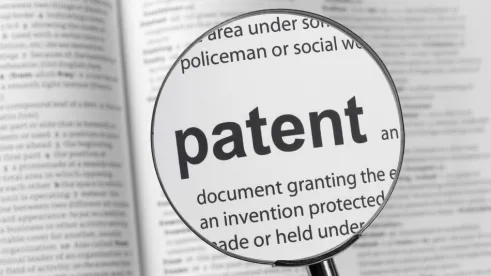Takeaway: A complex drawing submitted in order to show conception antedating an applied reference may require additional explanation or support if it is not possible to determine from the drawing how the depicted subject matter supports the elements of the claim in question.
In its Final Written Decision, the Board found that claims 52, 53, 59, and 60 of the ‘397 patent are unpatentable. Also, the Board denied Patent Owner’s Motion to Exclude.
The Board had instituted inter partes review of claims 45, 52, 53, 59, 60, and 66 of the ‘397 patent on the following grounds: (1) anticipation of claims 52, 53, and 66 under 35 U.S.C. § 102(a) in view of DE ‘265; (2) obviousness of claim 45 under 35 U.S.C. § 103 in view of JP ‘566; (3) obviousness of claims 52, 53, 59, 60, and 66 under 35 U.S.C. § 103 in view of JP ‘832 and JP ‘771; and (4) obviousness of claim 45 under 35 U.S.C. § 103 in view of JP ‘566 and JP ‘832. After the Board has instituted its review, Patent Owner filed a statutory disclaimer of claims 45 and 66. This action mooted grounds (2) and (4).
The ‘397 patent relates to a vehicle seat assembly comprising “an active head restraint system.” When a rear collision occurs, various structures of the assembly cause a head restraint to move toward the head and neck area of the occupant.
Patent Owner had not contested “that DE ‘265 describes all elements of claims 52 and 53” or “that the combination of JP ‘832 and JP ‘771 describes all elements of claims 52, 53, 59, and 60.” Instead, Patent Owner had only argued “that DE ’265 is not prior art under 35 U.S.C. § 102(a),” that “combining JP ‘771 with JP ‘832 renders JP ‘832 unfit for its intended purpose[,]” “that DE ’265 is not prior art as to claims 52 and 53[,] and that it would not have been obvious to have combined JP ‘771 with JP ‘832.
As for ground (1), the Board found that DE ‘265 is prior art under 35 U.S.C. § 102(a) and that DE ‘265 anticipates claims 52 and 53. Patent Owner had attempted to antedate DE ‘265 by way of a declaration of inventor Mladen Humer. However, the Board found that Patent Owner had failed to submit supporting testimony that would show that the annotations in the antedating evidence correlated to the elements in claims 52 and 53 that they were alleged to match. Consequently, the Board “[considered] Lear’s annotations to be attorney argument unsupported by evidence” and, “[w]ithout such evidentiary support,” found that “Lear’s argument that Mr. Humer conceived the invention of claims 52 and 53 before publication of DE ‘265 is unpersuasive.”
The Board also found that even if evidentiary weight were to be ascribed to the submitted evidence, such evidence “still fails to demonstrate Mr. Humer’s conception of every feature recited in claims 52 and 53.” As an example, the Board found that the relied-upon exhibit “fails to illustrate whether or how lower armature 52 is connected to frame 38 via linkage 92” in an exploded drawing view provided by Patent Owner to provide conception support for the elements of claim 11. This led the Board to conclude that “DE ’265 qualifies as prior art under 35 U.S.C. § 102(a).”
With respect to ground (4), the Board was persuaded by Petitioner that “claims 52, 53, 59, and 60 are unpatentable as obvious in view of the combination of JP ‘832 and JP ‘771.” The Board was not persuaded by Patent Owner that “the intended purpose of JP ‘832 was to provide comfort for the occupant[.]” According to the Board, “although comfort may be among the purposes of the seat in JP ‘832, the primary focus in JP ‘832 is on supporting the occupant’s head during a collision.” Thus, the Board determined “that [Petitioner had] demonstrated by a preponderance of evidence that a skilled artisan would have recognized the advantages of adding a stiffener as described in JP ‘771 to the impact structure in JP ‘832 and would have been capable of doing so without compromising the comfort of the seat in JP ‘832.”
The Board denied Patent Owner’s Motion to Exclude in all respects. According to the Board, “the Motion is moot because it seeks to exclude evidence not considered or relied upon in rendering this Decision[.]” Moreover, “the Motion addresses issues more appropriate to determining the weight ascribed to the evidence rather than the admissibility of evidence.”
NHK Seating of America, Inc. v. Lear Corporation, IPR2014-01200 Paper 29: Final Written Decision
Dated: February 2, 2016
Patent: 6,955,397 C1
Before: Richard E. Rice, Mitchell G. Weatherly, and Carl M. DeFranco
Written by: Weatherly
Related Proceedings: Lear Corporation v. NHK Seating of America, Inc., No. 2:13-cv-12937-SJM-RSW (E.D. Mich.), filed July 5, 2013; Ex Parte Reexamination Control No. 90/012,836; IPR 2014-00925; IPR 2014-01202; IPR 2014-01079; IPR 2014-01101; IPR 2014-01026; and IPR 2014-00957



 />i
/>i

